
Using cards with integers on them to practice multiplying and dividing integers
- Subject:
- Mathematics
- Material Type:
- Activity/Lab
- Author:
- EngageNY
- New York State Education Department
- Date Added:
- 08/06/2020

Using cards with integers on them to practice multiplying and dividing integers

(Nota: Esta es una traducción de un recurso educativo abierto creado por el Departamento de Educación del Estado de Nueva York (NYSED) como parte del proyecto "EngageNY" en 2013. Aunque el recurso real fue traducido por personas, la siguiente descripción se tradujo del inglés original usando Google Translate para ayudar a los usuarios potenciales a decidir si se adapta a sus necesidades y puede contener errores gramaticales o lingüísticos. La descripción original en inglés también se proporciona a continuación.)
Este módulo de 25 días se basa directamente en los estudiantes que trabajan con multiplicación y división en el módulo 1. El módulo 3 extiende el estudio de factores de 2, 3, 4, 5 y 10 para incluir todas las unidades de 0 a 10, así como múltiples de 10 dentro de 100. Similar a la organización del Módulo 1, la introducción de nuevos factores en el módulo 3 se extiende a través de temas. Esto permite a los estudiantes construir fluidez con hechos que involucran una unidad en particular antes de continuar. Los factores están secuenciados para facilitar la instrucción sistemática con estrategias y patrones cada vez más sofisticados.
Encuentre el resto de los recursos matemáticos de Engageny en https://archive.org/details/engageny-mathematics.
English Description:
This 25-day module builds directly on students work with multiplication and division in Module 1. Module 3 extends the study of factors from 2, 3, 4, 5, and 10 to include all units from 0 to 10, as well as multiples of 10 within 100. Similar to the organization of Module 1, the introduction of new factors in Module 3 spreads across topics. This allows students to build fluency with facts involving a particular unit before moving on. The factors are sequenced to facilitate systematic instruction with increasingly sophisticated strategies and patterns.
Find the rest of the EngageNY Mathematics resources at https://archive.org/details/engageny-mathematics.

(Nota: Esta es una traducción de un recurso educativo abierto creado por el Departamento de Educación del Estado de Nueva York (NYSED) como parte del proyecto "EngageNY" en 2013. Aunque el recurso real fue traducido por personas, la siguiente descripción se tradujo del inglés original usando Google Translate para ayudar a los usuarios potenciales a decidir si se adapta a sus necesidades y puede contener errores gramaticales o lingüísticos. La descripción original en inglés también se proporciona a continuación.)
El módulo 6 establece la base conceptual para la multiplicación y la división en el grado 3 y para la idea de que los números distintos de 1, 10 y 100 pueden servir como unidades. Los temas en este módulo incluyen: formación de grupos iguales, matrices y grupos iguales, matrices rectangulares como base para la multiplicación y división, y el significado de números par y impares.
Encuentre el resto de los recursos matemáticos de Engageny en https://archive.org/details/engageny-mathematics.
English Description:
Module 6 lays the conceptual foundation for multiplication and division in Grade 3 and for the idea that numbers other than 1, 10, and 100 can serve as units. Topics in this module include: Formation of Equal Groups, Arrays and Equal Groups, Rectangular Arrays as a Foundation for Multiplication and Division, and The Meaning of Even and Odd Numbers.
Find the rest of the EngageNY Mathematics resources at https://archive.org/details/engageny-mathematics.

(Nota: Esta es una traducción de un recurso educativo abierto creado por el Departamento de Educación del Estado de Nueva York (NYSED) como parte del proyecto "EngageNY" en 2013. Aunque el recurso real fue traducido por personas, la siguiente descripción se tradujo del inglés original usando Google Translate para ayudar a los usuarios potenciales a decidir si se adapta a sus necesidades y puede contener errores gramaticales o lingüísticos. La descripción original en inglés también se proporciona a continuación.)
En este módulo de 43 días, los estudiantes usan la comprensión del valor del lugar y las representaciones visuales para resolver problemas de multiplicación y división con números de múltiples dígitos. Como área clave de enfoque para el grado 4, este módulo se mueve lenta pero exhaustivamente para desarrollar la capacidad de los estudiantes para razonar sobre los métodos y modelos elegidos para resolver problemas con factores y dividendos de múltiples dígitos.
Encuentre el resto de los recursos matemáticos de Engageny en https://archive.org/details/engageny-mathematics.
English Description:
In this 43-day module, students use place value understanding and visual representations to solve multiplication and division problems with multi-digit numbers. As a key area of focus for Grade 4, this module moves slowly but comprehensively to develop students ability to reason about the methods and models chosen to solve problems with multi-digit factors and dividends.
Find the rest of the EngageNY Mathematics resources at https://archive.org/details/engageny-mathematics.

(Nota: Esta es una traducción de un recurso educativo abierto creado por el Departamento de Educación del Estado de Nueva York (NYSED) como parte del proyecto "EngageNY" en 2013. Aunque el recurso real fue traducido por personas, la siguiente descripción se tradujo del inglés original usando Google Translate para ayudar a los usuarios potenciales a decidir si se adapta a sus necesidades y puede contener errores gramaticales o lingüísticos. La descripción original en inglés también se proporciona a continuación.)
Módulo 4 de grado 5 extiende la comprensión del estudiante de las operaciones de fracción a la multiplicación y la división de fracciones y fracciones decimales. El trabajo procede de la interpretación de los gráficos de línea que incluyen mediciones fraccionales para interpretar las fracciones como división y razonamiento sobre la búsqueda de fracciones de conjuntos a través de la fracción por multiplicación de números enteros. El módulo procede a la fracción por multiplicación de fracción en formas de fracción y decimal. Una comprensión de la multiplicación como escala y multiplicación por N/N como multiplicación por 1 permite a los estudiantes razonar sobre productos y convertir fracciones en decimales y viceversa. Los estudiantes son presentados al trabajo de división con fracciones y fracciones decimales. Los casos de división se limitan a la división de números enteros por fracciones unitarias y fracciones unitarias por números enteros. Se introducen divisores de fracción decimal y la fracción equivalente y el pensamiento del valor del lugar permiten al alumno razonar sobre el tamaño de los cocientes, calcular los cocientes y colocar decimales con sensatez en los cocientes. A lo largo del módulo, se les pide a los estudiantes que razonen sobre estos conceptos importantes interpretando expresiones numéricas que incluyen operaciones de fracción y decimales y perseverar en la resolución de problemas de varios pasos en el mundo real que incluyen todas las operaciones de fracción compatibles con el uso de diagramas de cintas.
Encuentre el resto de los recursos matemáticos de Engageny en https://archive.org/details/engageny-mathematics.
English Description:
Grade 5s Module 4 extends student understanding of fraction operations to multiplication and division of both fractions and decimal fractions. Work proceeds from interpretation of line plots which include fractional measurements to interpreting fractions as division and reasoning about finding fractions of sets through fraction by whole number multiplication. The module proceeds to fraction by fraction multiplication in both fraction and decimal forms. An understanding of multiplication as scaling and multiplication by n/n as multiplication by 1 allows students to reason about products and convert fractions to decimals and vice versa. Students are introduced to the work of division with fractions and decimal fractions. Division cases are limited to division of whole numbers by unit fractions and unit fractions by whole numbers. Decimal fraction divisors are introduced and equivalent fraction and place value thinking allow student to reason about the size of quotients, calculate quotients and sensibly place decimals in quotients. Throughout the module students are asked to reason about these important concepts by interpreting numerical expressions which include fraction and decimal operations and by persevering in solving real-world, multistep problems which include all fraction operations supported by the use of tape diagrams.
Find the rest of the EngageNY Mathematics resources at https://archive.org/details/engageny-mathematics.
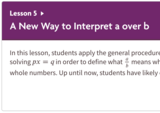
Unit 6: Expressions and Equations
Lesson 5: A New Way to Interpret a over b
In this lesson, students apply the general procedure they just learned for solving px=q in order to define what a/b means when a and b are not whole numbers. Up until now, students have likely only seen a fraction bar separating two whole numbers. This is because before grade 6, they couldn't divide arbitrary rational numbers. Now an expression like 2.5/8.9 or 1/2 / 3/5 can be well-defined. But the definition is not the same as what they learned for, for example, 2/5 in grade 3, where they learned that 2/5 is the number you get by partitioning the interval from 0 to 1 into 5 equal parts and then marking off 2 of the parts. That definition only works for whole numbers. However, in grade 5, students learned that 2 divided by 3 = 2/3, so in grade 6 it makes sense to define 2.5/8.9 as 2.5 divided by 8.9.
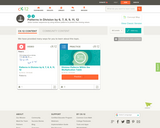
This short video and interactive assessment activity is designed to teach third graders about division patterns within the multiplication table.
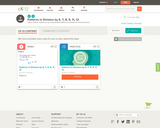
This short video and interactive assessment activity is designed to teach fourth graders about patterns in division by 6, 7, 8, 9, 11, 12.

This short video and interactive assessment activity is designed to teach fourth graders about using both division and multiplication - word problems.
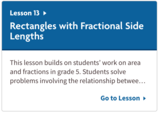
Unit 4: Dividing Fractions
Lesson 13: Rectangles with Fractional Side Lengths
This lesson builds on students’ work on area and fractions in grade 5. Students solve problems involving the relationship between area and side lengths of rectangles, in cases where these measurements can be fractions. Knowing that the area of a rectangle can be found by multiplying its side lengths, and knowing the relationship between multiplication and division, they use division to find an unknown side length when the other side length and the area are given.
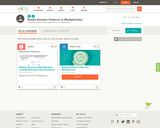
This short video and interactive assessment activity is designed to teach fifth graders about multiplication patterns over increasing place values.

This short video and interactive assessment activity is designed to teach fourth graders about patterns without using multiplication.
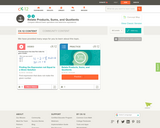
This short video and interactive assessment activity is designed to teach fourth graders about express the sentence and calculate - division.

This short video and interactive assessment activity is designed to teach fourth graders about selecting the incorrect statement.
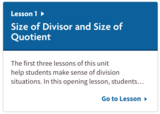
Unit 4: Dividing Fractions
Lesson 1: Size of Divisor and Size of Quotient
The first three lessons of this unit help students make sense of division situations. In this opening lesson, students begin thinking about the relationships between the numbers in a division equation. They see that they can estimate the size of the quotient by reasoning about the relative sizes of the divisor and the dividend.
Students begin exploring these relationships in concrete situations. For example, they estimate how many thinner and thicker objects are needed to make a stack of a given height, and how many segments of a certain size make a particular length.
Later, they generalize their observations to division expressions (MP7). Students become aware that dividing by a number that is much smaller than the dividend results in a quotient that is larger than 1, that dividing by a number that is much larger than the dividend gives a quotient that is close to 0, and that dividing by a number that is close to the dividend results in a quotient that is close to 1.

Unit 4: Dividing Fractions
Lesson 16: Solving Problems Involving Fractions
In this lesson, students use their understanding of and their facility with all four operations to represent and solve problems involving fractions. The last activity requires students to make sense of the problem and persevere in solving it (MP1).

This short video and interactive assessment activity is designed to teach third graders about understanding division with remainders and illustrations.
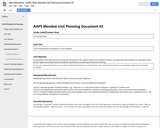
In this unit, children learn how to use a variety of math tools/strategies to solve problems. This unit lays the foundation for developing multiplication and division strategies.
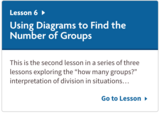
Unit 4: Dividing Fractions
Lesson 6: Using Diagrams to Find the Number of Groups
This is the second lesson in a series of three lessons exploring the “how many groups?” interpretation of division in situations involving fractions.
In the preceding lesson and in this one, the number of groups in each given situation is 1 or greater. In the next lesson, students find the number of groups that is less than 1 (“what fraction of a group?”).
Students have used different diagrams to represent multiplication and division. In this lesson, tape diagrams are spotlighted and used more explicitly. They are more abstract and more flexible than other representations students may have chosen for thinking about division problems that involve fractions. Because they use measurement along the length of the tape, tape diagrams are closer to the number line representation of fractions, and ultimately help students visualize division problems on the number line. (Students are not required to do that in this lesson, however.)
Students continue to make the journey from reasoning with concrete quantities to reasoning with abstract representations of fraction division (MP2).

Unit 5: Arithmetic in Base Ten
Lesson 10: Using Long Division
This lesson introduces students to long division. Students see that in long division the meaning of each digit is intimately tied to its place value, and that it is an efficient way to find quotients. In the partial quotients method, all numbers and their meaning are fully and explicitly written out. For example, to find 657/3 we write that there are at least 3 groups of 200, record a subtraction of 600, and show a difference of 57. In long division, instead of writing out all the digits, we rely on the position of any digit—of the quotient, of the number being subtracted, or of a difference—to convey its meaning, which simplifies the calculation.
In addition to making sense of long division and using it to calculate quotients, students also analyze some place-value errors commonly made in long division (MP3).